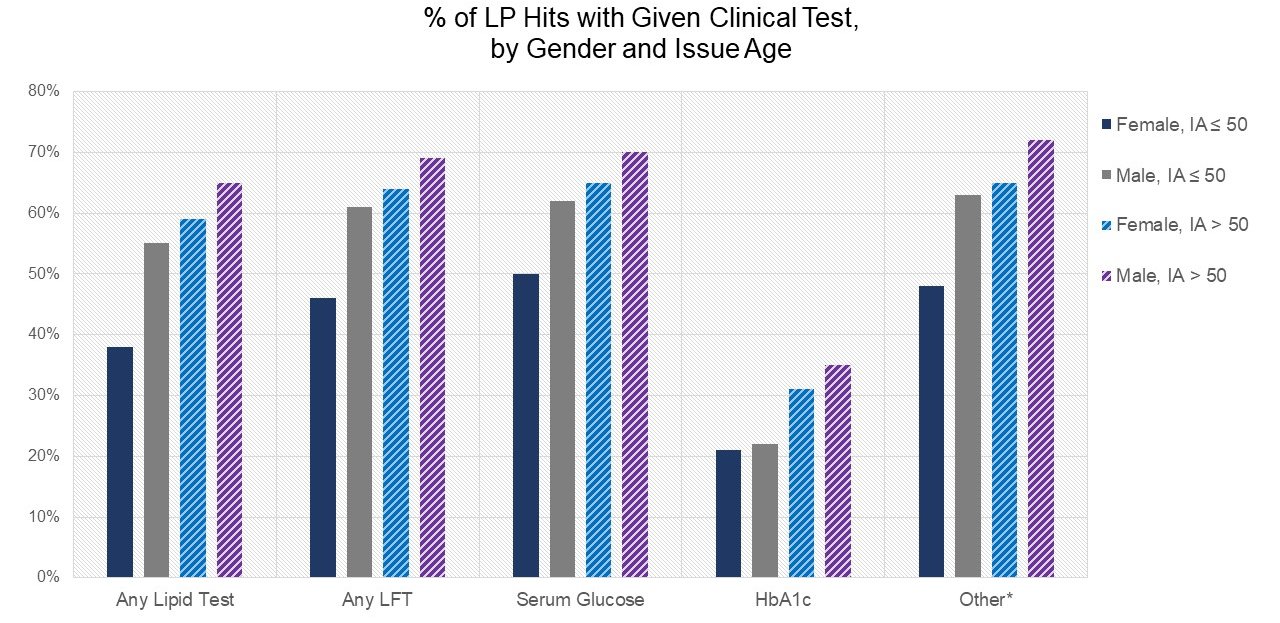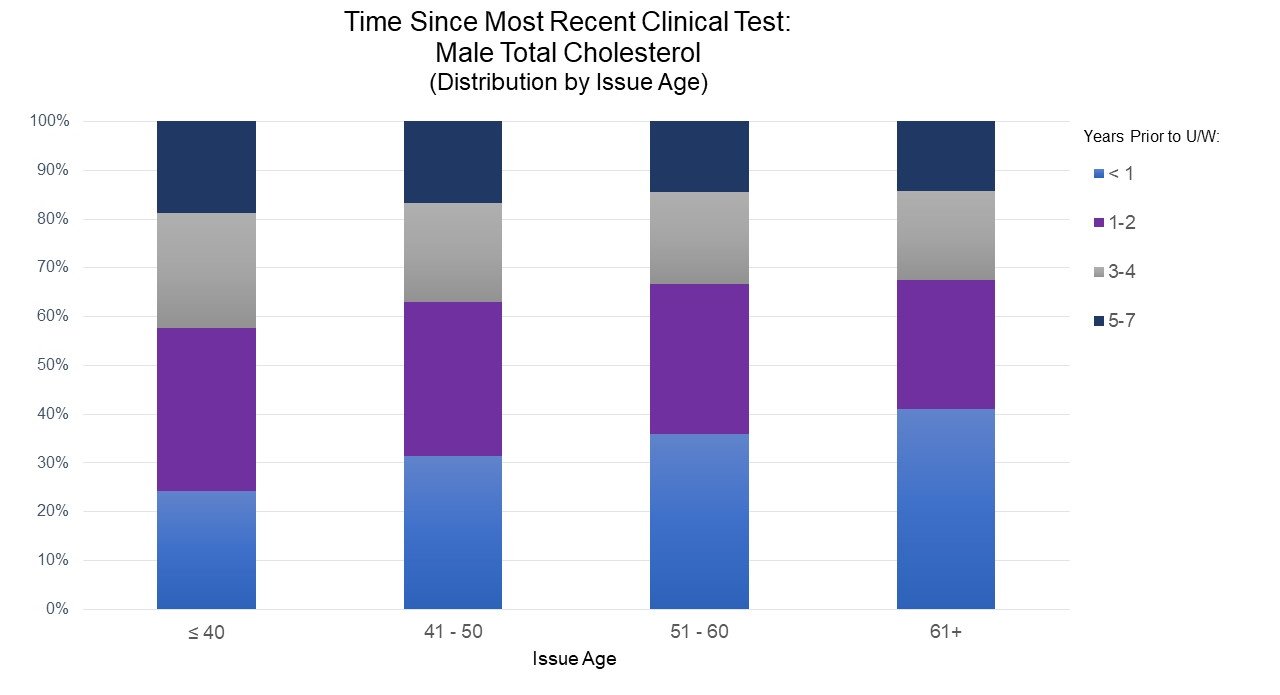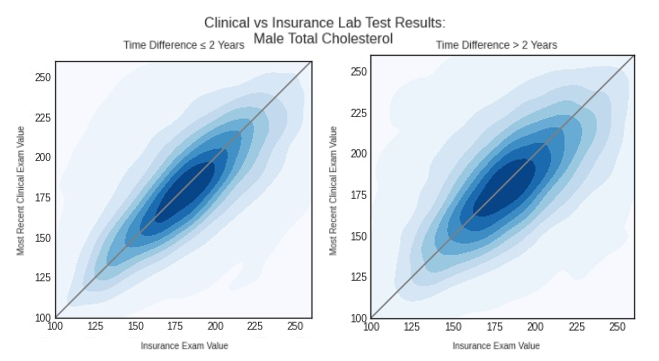
LabPiQture provides clinical laboratory test history for an insurance applicant, obtained from ExamOne’s extensive clinical laboratory database.
LabPiQture™ Overview
A LabPiQture report from ExamOne will contain up to seven years of clinical lab test results. These results are obtained from the vast network of Quest Diagnostics and LabCorp, and are populated with physician-ordered laboratory tests related to preventative care, disease monitoring and diagnostic purposes, with some additional coverage from biometric screenings. Additional medical context returned with the test results are date of service, ordering physician specialty, submitted diagnosis codes (ICD-9/10-CM), and a standardized test type identifier. This data is HIPAA compliant with applicant authorization and meets FCRA requirements.
Key Findings
- Clinical laboratory histories from ExamOne’s LabPiQture product contain tests results that are relevant to life underwriting. Lipids and most liver function tests are available on about 50-60% of LabPiQture records, and in those cases, multiple measurements for each lab over time are also common.
- The range of clinical tests available, such as Complete Blood Count panels that are typically not ordered as part of an insurance exam, may provide additional health insights. On the other hand, some lab tests that are commonly used in life underwriting, such as GGT and cotinine, are rarely available.
- Hit rates vary by age, gender, and geography. In this study dataset where all individuals had a LabPiQture record, insurance-relevant tests are found in the clinical histories at higher rates for males and for older ages.
- The most recent clinical test results are older than the corresponding insurance exam labs by a median difference of slightly under two years. Older issue ages have more recent clinical test results compared to younger ages for most insurance-relevant tests.
- Most applicants show alignment between the LabPiQture clinical test values and the insurance exam labs. The alignment tends to be stronger when the clinical test is more recent.
Study Data
The sample LabPiQture data supplied by ExamOne consists of approximately 72,000 unique life insurance applicants with LP hits. Additional processing of the raw LabPiQture records was necessary given the range of tests and result types returned. We decided to focus on lab tests that are typically ordered during life underwriting. Filtering down to those tests of interest was facilitated by LOINC codes, an international standard for uniquely identifying health measurements. Carriers looking to incorporate LabPiQture will also need to clean and filter the raw data as not all lab results returned are relevant to current underwriting practices, and may require unit standardization.
| Table 1: Data Summary | |
|---|---|
| Who | 72k recent US life insurance applicants who completed insurance exams with ExamOne and had a LabPiQture hit within 7 years of the date of insurance exam (proxy for underwriting date). - 52% Female, 48% Male - Females skewed slightly younger, with a median age of 44 vs 48 for males. - Nearly 50% of the individuals are from the South, with the remainder evenly distributed between the Northeast, Midwest, and West. |
| What | LabPiQture records: Over 10 million individual clinical test results, representing 5,000+ unique test types. Clinical results from multiple dates for a single test type/applicant may be observed. Additional fields specific to this study: - Applicant demographic profile - Insurance exam lab results |
| When | Insurance applications from 2017 Q2 to 2019 Q3 |
Insurance Related Lab Tests with High Prevalence in LabPiQture
| Table 2. Test Prevalence in LabPiQture (LP) | |
|---|---|
| Test Name | # LP hits with test / Total # of LP hits for each test listed |
| Lipids – Total Cholesterol, HDL, LDL & Triglycerides | 51-52% |
| Liver function tests (LFT) – AST, ALT, ALP & Bilirubin | 57-58% |
| Sugar metabolism – Serum Glucose – HbA1c | - 60% - 26% |
| Other blood tests – Albumin, Globulin, Serum Creatinine & BUN | 56-59% |
Prevalence Patterns by Age and Gender
In this sample data, male records are more likely than female records to have at least one clinical result for the core test groupings identified in Table 2. This is depicted in Figure 1, which also shows that these gender differences are larger at younger issue ages. This is partially explained by Ob/Gyn related tests for younger females, where having an Ob/Gyn related clinical encounter may generate a LabPiQture hit for a female applicant, but does not necessarily result in insurance-relevant tests. Most of the clinical results identified in Table 2 are generated by general/family practice or internal medicine related visits.
Figure 1 also shows that older issue ages have higher prevalence for these clinical tests compared to younger ages (after controlling for gender). Differences are also observed by region, with lower prevalence in the Midwest (not shown). Please note that these patterns relate to individuals with LabPiQture records (i.e. any clinical lab history), and not overall hit rates.

Time Difference Between Clinical Tests and Underwriting

Clinical Test Results From Multiple Dates
Clinical vs Insurance Exam Result Consistency
As this sample dataset was populated with both LabPiQture hits and insurance exam lab test results, we could compare the consistency of lab values obtained from these two sources. An example of the graphical approach used is detailed in the appendix below (Figure 3), shown specifically for male total cholesterol.
We generally observe positive association each for the lab tests addressed previously in Table 2. The clinical test result and the insurance exam result also tend to be more similar in value when the time difference between the two is shorter. Blood glucose clinical tests do show more variance relative to the corresponding insurance exam value than most of the other lab tests, which may be related to lower stability of blood glucose measurements over time, different fasting regimes prior to testing, and/or degradation of samples due to glycolysis.
Insurance Related Lab Tests with Low Prevalence in LabPiQture
Some insurance-relevant labs that are found infrequently in the clinical histories in this sample include:
- Biometric measurements such as height, weight, and blood pressure: Some results are found for about 2% of hits.
- Cotinine (whether obtained from blood serum, urine, or saliva): Very rare as testing for smoking lacks clinical diagnostic significance.
- GGT: Available on less than 4% of records in this sample; infrequently ordered in clinical settings compared to the rest of the liver function tests.
- Qualitative and semi-quantitative urinalysis (for example, urine creatinine, protein, glucose or albumin): Roughly 7-25% prevalence per test, but requires extra refinement to only capture the exact tests of highest relevance.
- Drug Abuse Screens (Opioids, Marijuana, Cocaine, etc): Present in approximately 3% of records.
In addition, the following labs are found at slightly higher rates, though with strong gender and age patterns:
- PSA: Over 50% of records for males over the age of 45 have at least one result.
- HIV: For females, the highest test prevalence is observed at issue ages under 40 (~35% of records have a related test), and overall, 21% of female records have a test. Males have a less steep trend by age and an overall prevalence of 12%.
- Hepatitis B: Very similar to HIV.
- Hepatitis C: Age and gender differentiation is similar to Hepatitis B, but less extreme. Overall, 20% of female records and 16% of male records have a result.
The consequences of not being able to rely on clinical histories for obtaining these labs which have protective value for insurance underwriting depends on the how LabPiQture results are incorporated into an underwriting workflow as well as any overlapping data sources available (i.e. medical disclosures, additional third-party evidence such as prescription drug records, smoker misrepresentation predictive model output, etc).
Additional Lab Tests
| Table 3. Additional Labs Available From LabPiQture | |
|---|---|
| Panel Name | Prevalence |
| Complete Blood Count - RBC, hemoglobin, hematocrit, WBC, WBC differential, platelets | Approx. 60% of hits had at least one test. |
| Thyroid - TSH, T3, T4 | More than 50% of hits had at least one test. |
| Others: inflammation markers, vitamin deficiency, male/female hormones, urine culture, pap smear, etc. | |
Production Hit Rates
LabPiQture in Practice
The clinical test histories obtained from LabPiQture can complement current risk assessment practices or be used to develop new ones. For example, clinical test results could be used to trigger a specific underwriting path during accelerated underwriting, with the goal of increasing throughput while minimizing additional mortality cost. Under current COVID-19 pandemic conditions where obtaining insurance labs or APSs has come under additional strain, some carriers are using clinical labs in lieu of insurance exams temporarily, or to move the process along more quickly.
The structured nature of the LabPiQture record means that after an initial exploration stage, automating data cleaning and standardization would be fairly straightforward for common tests. This is particularly relevant if the data is consumed downstream by a rules engine or predictive model. Models may need to be calibrated to reflect some of the characteristics for clinical labs. For example, the presence of an HbA1c clinical test on its own may be informative, given that it tends to be ordered for cause, and so any missing value imputation would need to reflect this. Finally, LabPiQture results may contain additional lab tests not traditionally ordered during underwriting but known to be associated with mortality, which creates new opportunities for additional risk segmentation or protective value.
Summary
Munich Re’s analysis based on the collaborative study data provided by Exam One demonstrates that LabPiQture returns clinical test results that correspond with life insurance laboratory testing, as well as additional lab information such as other tests not commonly ordered in insurance exams or multiple measurements over time that could expand current risk assessment. Individual carriers should perform a study on their own block of business to assess hit rates and test prevalence as well as the cost-benefit of adopting this additional data source. Munich Re can work with insurers to set up the validation and cost-benefit study, and assist them in incorporating this additional information in their underwriting process.
We also recently validated ExamOne’s HealthPiQture scores, an analytics suite with multiple mortality score components, including a lab mortality score that is derived from LabPiQture clinical histories. Read more for discussion of the effectiveness of this score in segmenting mortality risk.
Appendix
Example: Clinical vs Insurance Exam Result Consistency
This collaborative study dataset was populated with both LabPiQture records and insurance exam lab test results, enabling a comparison of the consistency of lab values obtained from these two sources and the impact on underwriting outcomes. We used several approaches including graphical comparisons which are described here.Figure 3 shows example plots for males comparing the alignment of total cholesterol values from the actual insurance exam (on the x-axis) with the most recent clinical total cholesterol result (on the y-axis). Since a large number of applicants are considered and can’t be clearly shown as individual datapoints, the plot uses colored bands to summarize where the datapoints are located. Each colored bands represents the position of 12.5% of the total datapoints for a given plot. The visualization below is also split on the age of the clinical result relative to the insurance exam test in order to investigate if the magnitude of the time difference influences how closely the values align. Specifically, the left plot shows clinical labs that are less than 2 years older than the insurance lab test, and the right plot shows clinical labs that are over 2 years older. The applicants largely track with the gray line of equality (where clinical total cholesterol exactly equals insurance exam total cholesterol), showing alignment between the clinical and insurance results, although it is not perfect. Some differences between the clinical and insurance exam values are expected, possibly related to aging and change in health status over time or different laboratory protocols. The narrower the colored bands are and the tighter the bands lie along the gray line of equality, the greater the share of people where the clinical test values are most similar to the insurance exam values. So the narrower bands of the left plot indicate a slightly better consistency between the clinical and insurance exam total cholesterol results when the clinical results are more recent.

Contact the author:
/Julia%20Druce.jpg/_jcr_content/renditions/original./Julia%20Druce.jpg)
Related Content
Newsletter
properties.trackTitle
properties.trackSubtitle



